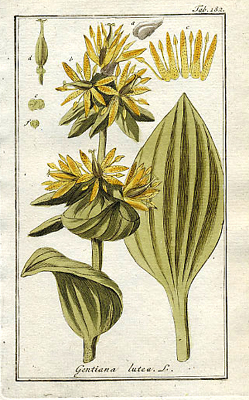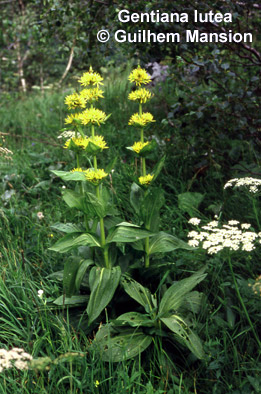SEARCH the
Gentian Research Network
and Rutgers University:
GENTIANS
Classification (newest)
List of genera
List by tribe
Gentian characteristics
Gentianales
RESEARCH
Research projects
People, addresses
Literature, publications
Links
Add info to
this site
TOPICS
Anatomy
Common names
Ecology - Natural history
GEOGRAPHY
Floras
Latin America
North America
TRIBES
Saccifolieae
_____________________
Information in other languages:
_____________________
This page
is maintained
by Dr.
Lena
Struwe
(e-mail),
and hosted by
Rutgers University, USA
updated: 01/19/11
| Gentiana
lutea (Gentianaceae: Gentianeae: Gentianinae: Gentiana: Gentiana lutea) |
|
|
Common name: yellow gentian Latin name and synonyms: Gentiana lutea L. Distribution: The plant is common in mountainous regions of Europe, including the Alps, Jura, Massif Central, and Pyrenees. Habitat: It grows at rather low elevation in alpine meadows, and blossoms from July to August. Characteristics: Perennial herb with large tap root and at least up to 1 m tall. Leaves large and deeply veined, in basal rosette until flowering. Flowers in terminal and axillary clusters, each cluster with a large leaf below it. Corolla deeply divided, yellow (petals nearly free), and not with folds (plicae) between lobes. Economic uses: This species is commonly used for medicinal purposes and to flavor alcoholic drinks (bitters). The root is harvested by digging up whole plants. Gentianae Radix is the pharmaceutical name of the root of Gentiana lutea. (see comic) Notes: This
is one of the few species in Gentiana that has rotate (very
deeply divided) corollas and no glandular disk at the base of the ovary.
It is also the type species of the genus Gentiana, despite its
atypical flowers. |
|

From: Zorn (1790) Medicinal Botany |
 |
|
References and publications: |
|
|
Text: © Lena Struwe, 2003 All photos are copyrighted by the photographer - if you want to use them for any purpose you need to get permission for each photo. Contact the photographer directly; Gentian Research Network does not give out permission for use of photos posted on this site. |
|
